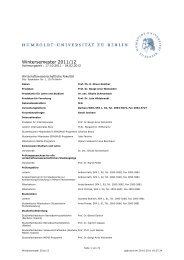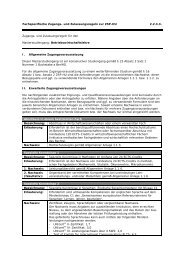Measuring the Effects of a Shock to Monetary Policy - Humboldt ...
Measuring the Effects of a Shock to Monetary Policy - Humboldt ...
Measuring the Effects of a Shock to Monetary Policy - Humboldt ...
You also want an ePaper? Increase the reach of your titles
YUMPU automatically turns print PDFs into web optimized ePapers that Google loves.
8 Bayesian FAVARs with Agnostic Identification<br />
ambiguously 2 3 . In <strong>the</strong> current literature <strong>the</strong>re are also approaches <strong>to</strong> consider an index<br />
extracted with dynamic fac<strong>to</strong>r models, representing <strong>the</strong> relevant dynamics out <strong>of</strong> many<br />
macroeconomic variables associated with ”economic activity”, such as Korenok and Rad-<br />
chenko [2004]. The consensus seems <strong>to</strong> be consistent with <strong>the</strong> ”monetary neutrality” that<br />
monetary policy shocks only affect <strong>the</strong> nominal but not <strong>the</strong> real sec<strong>to</strong>r in <strong>the</strong> long-run.<br />
Contrariwise Canova and De Nicolo [2002] show that monetary policy had a significant<br />
effect in reducing <strong>the</strong> output in <strong>the</strong> G7 industry countries, hence <strong>the</strong>y implicitly disagree<br />
with <strong>the</strong> ambiguous effects <strong>of</strong> monetary policy shocks mentioned by <strong>the</strong> papers above. The<br />
contentious issue raising <strong>the</strong> overall dissentation is ra<strong>the</strong>r <strong>the</strong> quantitative magnitude <strong>of</strong><br />
<strong>the</strong> reaction 4 instead <strong>of</strong> its mere direction. There are methods required <strong>to</strong> address such<br />
issues quantitatively, which is important for central bankers who have <strong>to</strong> decide how <strong>to</strong><br />
react <strong>to</strong> <strong>the</strong> state <strong>of</strong> <strong>the</strong> economy. In order <strong>to</strong> accomplish a sound decision, <strong>the</strong> monetary<br />
authorities have <strong>to</strong> be certain about <strong>the</strong> precise reaction <strong>of</strong> <strong>the</strong> economy. For example<br />
in a recession, it might be required <strong>to</strong> know about <strong>the</strong> accurate effects, in order <strong>to</strong> avoid<br />
a policy decision that might ra<strong>the</strong>r be a drag on <strong>the</strong> recovery. The broader <strong>the</strong> relevant<br />
information set <strong>the</strong> more accurate is analysis <strong>the</strong> for central bankers.<br />
The ”workhorse” in applied empirical macroeconomics for accomplishing <strong>the</strong> question<br />
at hand is <strong>the</strong> structural vec<strong>to</strong>r au<strong>to</strong>regression (Hence forth SVAR). The problem is that<br />
<strong>the</strong> VAR framework with its limitations such as <strong>the</strong> ”curse <strong>of</strong> dimensionality” 5 cannot<br />
mirror <strong>the</strong> reality <strong>of</strong> central bankers decision making, particularly w.r.t. <strong>the</strong> amount <strong>of</strong><br />
information exploited which apparently is relevant for <strong>the</strong> economy. This might be very<br />
important for researchers because <strong>the</strong>re is little hope that economists can evaluate al-<br />
ternative <strong>the</strong>ories <strong>of</strong> <strong>the</strong> monetary policy transmission mechanism, or obtain quantitative<br />
2 See Uhlig [2005]<br />
3 Some researchers measure <strong>the</strong> effects on output, some ra<strong>the</strong>r on industrial output as a representative<br />
”proxy” or ”index” for economic activity (see Sims).<br />
4 In my <strong>the</strong>sis I only consider <strong>the</strong> effects <strong>of</strong> contractionary monetary policy shocks.<br />
5 This was raised by Sims (1980), where he states that with increasing number <strong>of</strong> variables included in<br />
<strong>the</strong> VAR, <strong>the</strong> parameters <strong>to</strong> be estimated increase quadratically and soon become intractable.



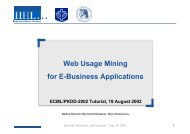
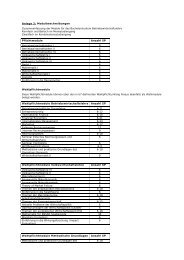


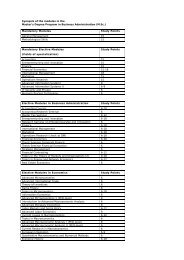
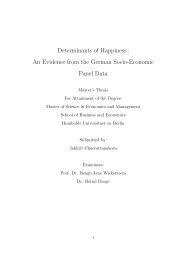
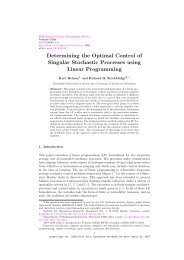



![[Text eingeben] [Text eingeben] Lebenslauf Anna-Maria Schneider](https://img.yumpu.com/16300391/1/184x260/text-eingeben-text-eingeben-lebenslauf-anna-maria-schneider.jpg?quality=85)

